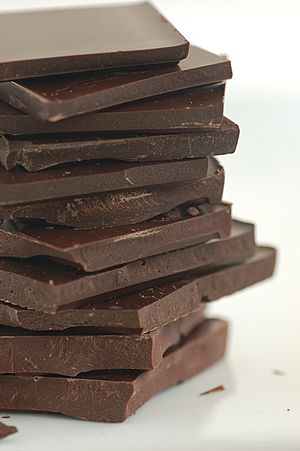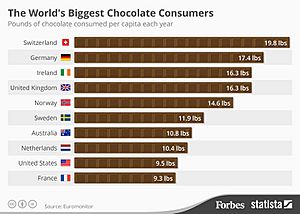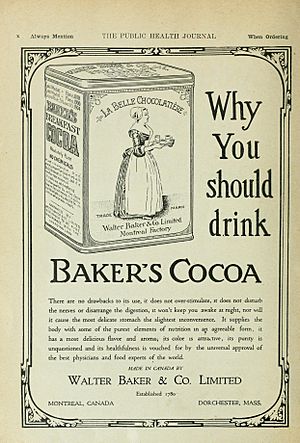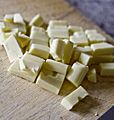Chocoholic facts for kids
A chocoholic is someone who really, really loves chocolate and feels like they need to eat it a lot. The word "chocoholic" was first used in 1968. People often use this word in a fun way, but some scientists think that craving chocolate can be a bit like a real addiction. Chocolate has special ingredients that can make you feel good, like tryptophan and phenylethylamine. These can make you crave it, especially if your body is made a certain way. The amount of sugar in chocolate also changes how it makes you feel.
Even though scientists are still discussing if chocolate addiction is a true addiction, chocolate (especially dark chocolate) is known to affect your mood. Chocolate treats are almost always at the top of the list of foods people say they crave. Sometimes, the craving can be so strong that chocoholics might feel a bit grumpy or restless if they don't get their chocolate fix.
Contents
Why Do People Crave Chocolate?
Chocolate is one of the most commonly craved foods for many reasons. Its yummy taste makes eating it a happy experience. The mix of sweetness, smoothness, and creaminess, both in taste and smell, makes it super appealing. Chocolate also has a lot of energy, which adds to the good feeling. This desire comes from special parts of your brain that make you want chocolate without you even realizing it. Eating chocolate creates a positive feeling, offering comfort and often helping you feel better when you're stressed or sad. Chocolate can also help balance brain chemicals like serotonin, which affects your mood. Because chocolate has fat and energy, it's often a top choice when someone is feeling stressed.
Chocolate cravings can also happen if your body is missing certain important nutrients. For example, cravings might mean you need more magnesium. Magnesium helps your brain chemicals work right, which affects your mood and digestion. When your blood sugar levels are out of balance, it can also increase cravings. When you eat sugar, your body releases insulin to lower blood sugar. Over time, this can lead to an imbalance, making you crave sugar to get more energy.
Your senses can also trigger chocolate cravings. Just smelling chocolate can make your brain more active and increase cravings compared to when there's no smell. For people who crave chocolate often, just seeing it can activate parts of their brain linked to rewards and making decisions.
The History of Chocolate
People have been enjoying chocolate for over 2000 years! For most of its history, chocolate was enjoyed as a drink. It only became a powdered form in the mid-1800s. Back then in Europe, chocolate was seen as an exciting drink and became very popular. In ancient Mexico, chocolate was only served to adult men, like government officials, military leaders, priests, and brave warriors. People thought chocolate was strong and stimulating, so it wasn't considered suitable for children or women.
The secret of chocolate's psychological effects was kept quiet in Spain during the 16th century. But in the early 17th century, Madrid became a popular place for fashion and society. Visitors traveling through Spain soon discovered the taste of chocolate. Spanish monks also taught their visiting family members the habit of drinking hot chocolate and told them about its health benefits. An early study by a Spanish monk named Bernardino de Sahagún warned against eating too much cacao. He said that large amounts of green cacao made people feel confused. But he praised smaller amounts of chocolate, saying that chocolate as a liquid made people feel refreshed.
Chocolate also had important medical uses. Drinking chocolate was thought to help digestion and heavy stomachs because it was known to promote good gut bacteria. It was also used to treat people with serious illnesses like tuberculosis. The strong taste of cacao was also used to hide the flavor of bad-tasting medicines. This is where the saying "a little bit of chocolate makes the medicine go down" might come from! Chocolate was even used to help treat people with bloody dysentery.
Chocolate was also valued for its nutritional benefits. In the 17th century, English soldiers in Jamaica survived for long periods by dissolving cacao paste in water with sugar, and they stayed strong. It's also known that Indian women would eat it so often and in such large amounts that it sometimes replaced meat in their diet.
How to Manage Chocolate Cravings
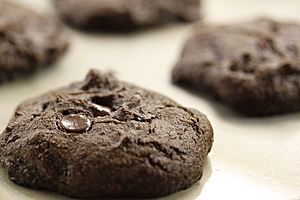
Making changes to what you eat can help you overcome strong chocolate cravings. Eating foods with protein and healthy fats can stop your body from releasing too much insulin. When too much insulin is released, it can lead to chocolate cravings. The amino acids in protein help build chemicals like dopamine, which can reduce cravings. Foods with fibre can also help balance your blood sugar and slow down digestion. Eating more foods rich in iron can also reduce your body's need for a quick energy boost from sugar. These foods include beans, lentils, and dark leafy green vegetables. Eating regular meals also helps keep your blood sugar levels steady. Sticking to a healthy meal plan with planned meals and snacks can help reduce the chance of chocolate cravings.
Chocolate cravings can also be linked to stress. Stress raises blood sugar levels because of a hormone called cortisol and the release of glucose from your liver. Not getting enough sleep can also make you want more sugar because your body tries to fight tiredness. Getting more hours of sleep can help reduce the need to eat chocolate.
Studies have shown that eating artificial sweeteners like aspartame, saccharin, and sucralose can actually increase chocolate cravings. This is because they are very sweet and can make you depend on sugar more. Trying substitute products in your diet can help reduce the craving for chocolate. An example is carob, which does not contain theobromine or caffeine (found in chocolate).
Improving your body's response to insulin can also help curb chocolate cravings. You can do this by consuming things like ginger and turmeric, which help your body absorb glucose better.
Images for kids
-
Cacao nibs, which are pieces of cocoa beans. They are often ground into chocolate liquor or added to chocolate bars for a crunch.
-
A glass of chocolate milk.
-
Chocolate ice cream cone.


